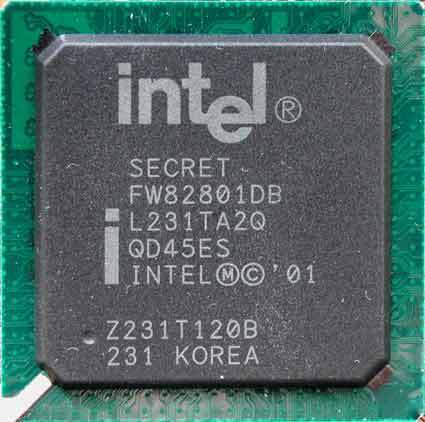Pentium 4 with Dual DDR: Endurance Test of Seven Motherboards with the Granite Bay Chipset
E7205, Alias Granite Bay: Technical Details
From a technical point of view, the E7205 has much in common with the high-end E7500/ 7505 chipset, which was developed for the Xeon processor. This refers above all to the highlight of this chipset, i.e., the dual-channel memory interface (buzzword "dual DDR"). When souped up with two or four DIM modules, the dual-channel mode is activated, providing the processor with double the bandwidth instead of the 2.1 GB/s usually available with DDR266.
This is an interesting figure, because 4.2 GB/s is exactly the maximum bandwidth that the Rambus DRAM is capable of under the PC1066 standard. While previous SDRAM chipsets in the 845 series were still inferior in performance to the RDRAM 850-class models, Granite Bay offers the same performance - at least on paper. However, as our testing article shows, the supposedly equally-fast Granite Bay chipset still falls just short of the 850E and the PC1066-RDRAM. The 32 bit RDRAM, with a speed of 533 MHz, seems to have advantages over the 2x 32 bit DDR-SDRAM with only 266 MHz.
Granite Bay, however, is unbeatable, thanks to its minimal heat and low price for DDR266, which carries considerable weight when it comes to module capacities above 512 MB. Here the E7205 is the clear leader among the Intel chipsets, because neither 845 nor 850 can manage 4 GB RAM.
Granite Bay is divided into two chips: one is the Northbridge E7205 or "memory controller hub," as Intel calls it. At 1005 pins, this chip is very large. No wonder, because it also contains the processor and memory interface as well as a current Version 3.0 AGP interface (AGP 8X).
The Southbridge is better known as the ICH4 and offers the same features as boards with an 845E or an 850E chipset. These include a maximum of six USB 2.0 ports, an integrated UltraATA/ 100 IDE interface, and audio and network controllers.
Get Tom's Hardware's best news and in-depth reviews, straight to your inbox.
Current page: E7205, Alias Granite Bay: Technical Details
Prev Page Clocking Games, Synchronous Transfer And 1530 MHz Arms Races Next Page Dual DDR: Following The Footsteps Of RDRAM
Patrick Schmid was the editor-in-chief for Tom's Hardware from 2005 to 2006. He wrote numerous articles on a wide range of hardware topics, including storage, CPUs, and system builds.
